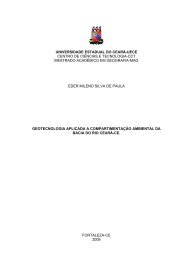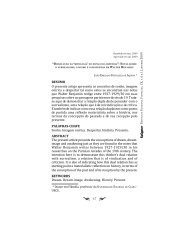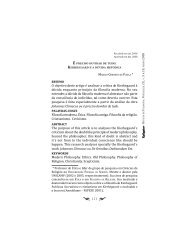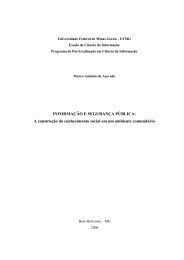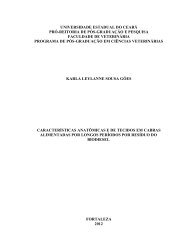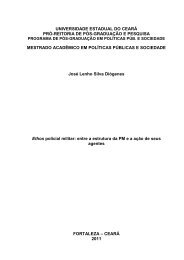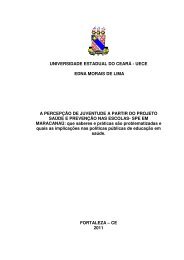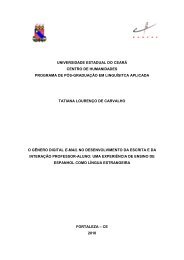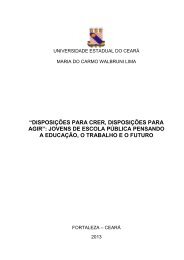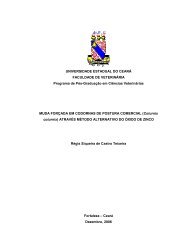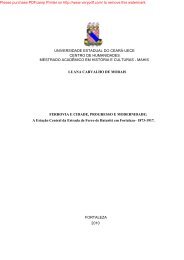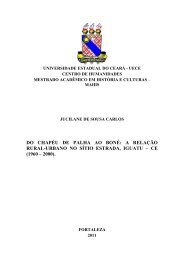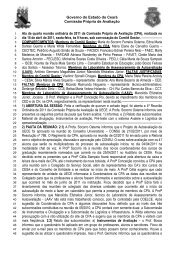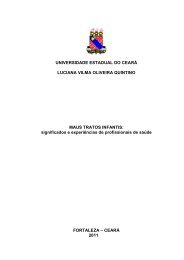Avaliação da temperatura, umidade e vacinação in ovo
Avaliação da temperatura, umidade e vacinação in ovo
Avaliação da temperatura, umidade e vacinação in ovo
Create successful ePaper yourself
Turn your PDF publications into a flip-book with our unique Google optimized e-Paper software.
to 37.5°C <strong>in</strong>creases not only the chick hatch weight but it also promotes longer leg<br />
bones, more muscle fibers and nuclei <strong>in</strong> the gastrocnemius, more <strong>in</strong> <strong>ovo</strong> embryo motility<br />
dur<strong>in</strong>g <strong>in</strong>cubation and a reduction <strong>in</strong> adipose tissue. However much higher temperatures<br />
can be potentially detrimental to <strong>in</strong>cubation of quail eggs, s<strong>in</strong>ce Leksrisompong (2005)<br />
observed that chicken eggs <strong>in</strong>cubated <strong>in</strong> temperatures from 39.5 to 40.6°C showed body<br />
weight, and weights of the heart, gizzard, proventriculus, and small <strong>in</strong>test<strong>in</strong>es frequently<br />
reduced.<br />
Hatch time<br />
The <strong>in</strong>cubation time can be <strong>in</strong>fluenced by many factors like temperature (Suarez<br />
et al., 1996; Wilson, 1991), egg weight (Burton and Tullet, 1985), age of breeder (Smith<br />
and Bohren, 1975) and also pre<strong>in</strong>cubation storage (Bohren, 1978). Incubation<br />
temperatures above the optimal temperature have been reported to accelerate growth<br />
rates of avian embryos (Romanoff, 1960; Christensen et al., 1999). The <strong>in</strong>cubation<br />
temperature highly <strong>in</strong>fluenced the hatch<strong>in</strong>g time of Japanese quail eggs. The lower<br />
temperature that allowed embryo hatch<strong>in</strong>g was 35°C. Compared to 38°C this<br />
temperature <strong>in</strong>creased almost 5 <strong>da</strong>ys <strong>in</strong> the hatch<strong>in</strong>g time. Chicken eggs <strong>in</strong>cubated <strong>in</strong> the<br />
same temperatures had a lower difference between the hatch<strong>in</strong>g times, which was 4 <strong>da</strong>ys<br />
(Tazawa et al., 1988). Pedroso et al. (2006) found similar hatch<strong>in</strong>g times for Japanese<br />
quail eggs; however they studied <strong>in</strong>cubations at 36.5C and 37.5°C with 442.5 and 413.6<br />
hours, respectively. The change of <strong>in</strong>cubation temperature for small periods can also<br />
<strong>in</strong>fluence the hatch<strong>in</strong>g time as reported by Leandro et al. (2000) that verified the effects<br />
of small period (5 hours) of heat (40°C) or cold (32°C) stress <strong>in</strong> chicken eggs <strong>in</strong>cubated<br />
at 37.8°C and verified an <strong>in</strong>crease of hatch<strong>in</strong>g time around 10 and 8 hours, respectively.<br />
Embryo mortality<br />
Embryo mortality pattern of Japanese quail eggs was similar to the one observed<br />
<strong>in</strong> chickens, <strong>in</strong> which there are two phases of <strong>in</strong>creased embryonic mortality dur<strong>in</strong>g<br />
<strong>in</strong>cubation: the first phase occurs dur<strong>in</strong>g the first week of <strong>in</strong>cubation and the second<br />
phase dur<strong>in</strong>g the last week (Jassim et al., 1996). This way the <strong>in</strong>termediate embryo<br />
death was less frequent than the other mortality classifications for temperatures that had<br />
hatched quails. In general, all embryo mortality classifications tended to be lower for<br />
eggs <strong>in</strong>cubated <strong>in</strong> the central temperatures (37°C and 38°C). Embryos seemed to be<br />
resistant to embryo death <strong>in</strong> high temperatures of <strong>in</strong>cubation up to 40°C at the early<br />
41



